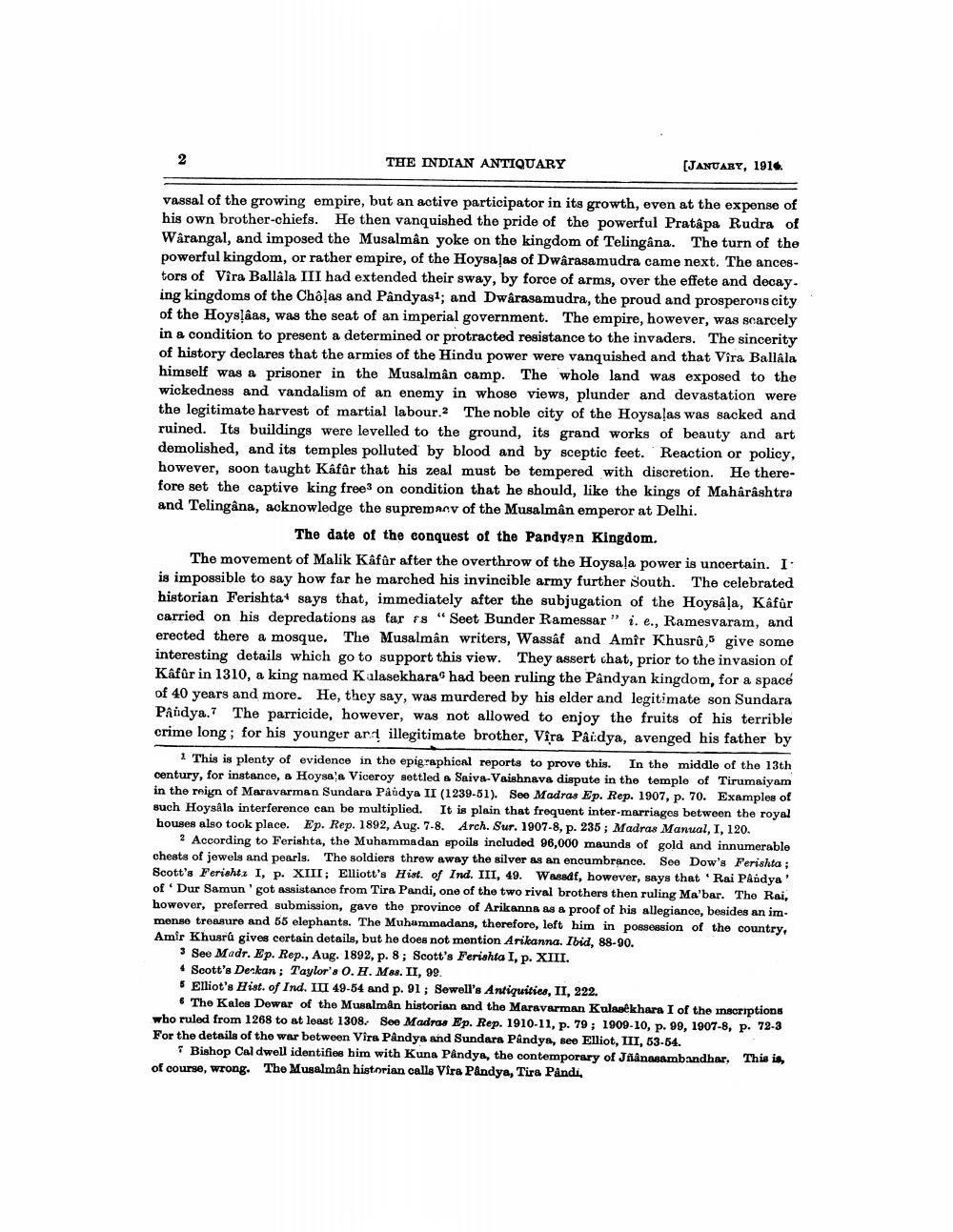Book Title: Indian Antiquary Vol 43 Author(s): Richard Carnac Temple, Devadatta Ramkrishna Bhandarkar Publisher: Swati Publications View full book textPage 6
________________ THE INDIAN ANTIQUARY (JANUARY, 1914 vassal of the growing empire, but an active participator in its growth, even at the expense of his own brother-chiefs. He then vanquished the pride of the powerful Pratâpa Rudra of Warangal, and imposed the Musalman yoke on the kingdom of Telingana. The turn of the powerful kingdom, or rather empire, of the Hoysaļas of Dwarasamudra came next. The ancestors of Vira Ballâla III had extended their sway, by force of arms, over the effete and decay. ing kingdoms of the Chôļas and Pandyası; and Dwarasamudra, the proud and prosperons city of the Hoys!âas, was the seat of an imperial government. The empire, however, was scarcely in a condition to present a determined or protracted resistance to the invaders. The sincerity of history declares that the armies of the Hindu power were vanquished and that Vira Ballála himself was a prisoner in the Musalmân camp. The whole land was exposed to the wickedness and vandalism of an enemy in whose views, plunder and devastation were the legitimate harvest of martial labour. The noble city of the Hoysalas was sacked and ruined. Its buildings were levelled to the ground, its grand works of beauty and art demolished, and its temples polluted by blood and by sceptic feet. Reaction or policy, however, soon taught Káfûr that his zeal must be tempered with discretion. He therefore set the captive king free on condition that he should, like the kings of Maharashtra and Telingana, acknowledge the supremany of the Musalman emperor at Delhi. The date of the conquest of the Pandyan Kingdom. The movement of Malik Kâfâr after the overthrow of the Hoysala power is uncertain. I. is impossible to say how far he marched his invincible army further South. The celebrated historian Ferishtat says that, immediately after the subjugation of the Hoysâļa, Kafür carried on his depredations as far rs “Seet Bunder Ramessar" i. e., Ramesvaram, and erected there a mosque. The Musalman writers, Wassaf and Amir Khusrû,5 give some interesting details which go to support this view. They assert chat, prior to the invasion of Kafür in 1310, a king named Kalasekhara had been ruling the Pandyan kingdom, for a space of 40 years and more. He, they say, was murdered by his elder and legitimate son Sundara Paidya. The parricide, however, was not allowed to enjoy the fruits of his terrible crime long; for his younger and illegitimate brother, Vira Paidya, avenged his father by This is plenty of evidence in the epigraphical reports to prove this. In the middle of the 13th century, for instance, & Hoysa a Viceroy settled a Saiva-Vaishnava dispute in the temple of Tirumaiyam in the reign of Maravarman Sundara Paidya II (1239-51). See Madras Ep. Rep. 1907, p. 70. Examples of such Hoysa la interference can be multiplied. It is plain that frequent inter-marriages between the royal houses also took place. Ep. Rep. 1892, Aug. 7-8. Arch. Sur. 1907-8, p. 235; Madras Manual, I, 120. ? According to Ferishta, the Muhammadan spoils included 96,000 maunds of gold and innumerable chests of jewels and pearls. The soldiers threw away the silver as an encumbrance. See Dow's Ferishta; Scott's Ferishta I, p. XIII; Elliott's Hist. of Ind. III, 49. Wassdf, however, says that 'Rai Pâödya' of Dur Samun 'got assistance from Tira Pandi, one of the two rival brothers then ruling Ma'bar. The Rai, however, preferred submission, gave the province of Arikanna as a proof of his allegianco, besides an immense tremure and 65 elephants. The Muhammadans, therefore, left him in possession of the country, Amir Khusrü gives certain details, but he does not mention Arikanna. Ibid, 88-90. 3 See Madr. Ep. Rep., Aug. 1892, p. 8; Scott's Ferishta I, p. XIII. 4 Scott's Derkan; Taylor's 0. H. M88. II, 99. 5 Elliot's Hist. of Ind. III 49-54 and p. 91 ; Sewell's Antiquities, II, 222. 6 The Kalea Dewar of the Musalman historian and the Maravarman Kulasekhara I of the inscriptions who ruled from 1268 to at least 1308. Soe Madras Ep. Rep. 1910-11, p. 79 ; 1909-10, p. 99, 1907-8, p. 72-3 For the details of the war between Vira Påndya and Sundara Pandys, see Elliot, III, 53-54. Bishop Caldwell identifice him with Kuna Pândye, the contemporary of JAnasambandhar, This is of course, wrong. The Musalman historian calls Vira Påndya, Tira Pandi,Page Navigation
1 ... 4 5 6 7 8 9 10 11 12 13 14 15 16 17 18 19 20 21 22 23 24 25 26 27 28 29 30 31 32 33 34 35 36 37 38 39 40 41 42 43 44 45 46 47 48 49 50 51 52 53 54 55 56 57 58 59 60 61 62 ... 344
